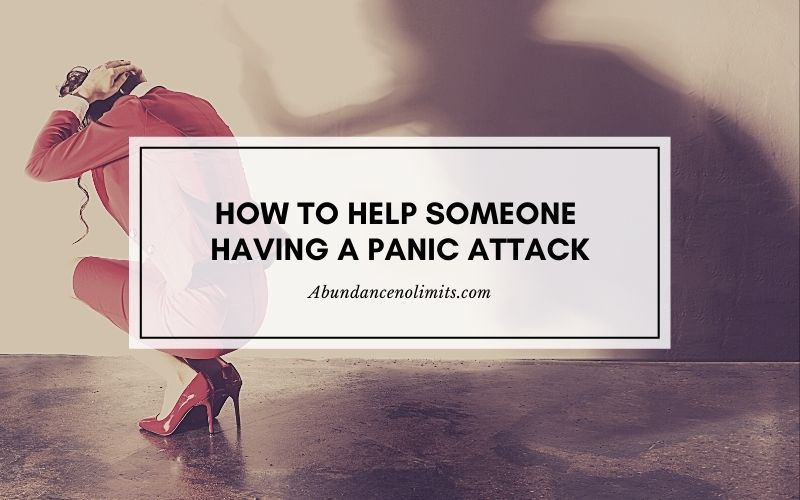Panic attacks are scary to experience and scarier to witness in another person.
It is even more frightening to witness a panic attack when the other person is at the other end of the phone. That too when you are texting them.
But you can’t just walk away as if nothing happened without making an effort to help them deal with it.
To help someone having an anxiety attack over text is challenging but not impossible. The most important thing is to stay on the phone and continue your conversation with them. This gives you their attention and you can use this to help them focus on the right thing.
It is vital that you understand the do’s and don’ts of dealing with a panic attack. Read on to learn more about panic attacks and the best way to deal with them. You will also find here suggestions on what to say to someone with anxiety over text.
What is a panic attack?
As the name itself suggests, it is a sudden onslaught of emotions, often accompanied by physical symptoms, triggered by extreme anxiety and fear, with no apparent cause or real danger. It usually manifests as intense physical pain or even as a constriction of the heart similar to a heart attack.
When a person is experiencing a panic attack they feel as if they are dying. For them, there is a real feeling of hopelessness and approaching doom.
Diagnostic and Statistical Manual of Mental Disorders, 5th Edition or DSM-5 as it is popularly known, is the taxonomic and diagnostic tool published by the American Psychiatric Association and used by mental health professionals in the United States. It describes the panic attack as follows.
A panic attack is an abrupt period of intense fear or discomfort accompanied by 4 or more of the following 13 systemic symptoms:
- Palpitations, pounding heart, or accelerated heart rate
- Sweating
- Trembling or shaking
- Sensations of shortness of breath or smothering
- A feeling of choking
- Chest pain or discomfort
- Nausea or abdominal distress
- Feeling dizzy, unsteady, lightheaded, or faint
- Feelings of unreality (derealization) or being detached from oneself (depersonalization)
- Fear of losing control or going crazy
- Fear of dying
- Numbness or tingling sensations (paresthesias)
- Chills or hot flushes
Fewer than 4 symptoms can be classified as a mild episode or a limited-symptom anxiety disorder. Panic attacks can be expected or unexpected based on the triggers.
How to help someone with a panic attack?
When you are witnessing an episode of an anxiety disorder in someone, you need to be aware of the fact that they are experiencing high levels of anxiety or fear and are unable to think with clarity. You can help by:
- Continue to be with them and hold their attention.
- Help them stay calm.
- Talk to them in an easy-to-understand and concise way.
- Don’t spring surprises. Ensure your actions are predictable.
- If you are aware of their medication for panic attacks, get it for them.
- Desist from making assumptions about their preferences. Ask them what they want.
- Help them take deep breaths and slow it down by asking them to follow your example. Take long deep breaths to guide them.
- Count to 10 or 20 to help them focus.
What to tell someone experiencing panic disorders?
The sense of hopelessness is the overpowering emotion for a person having a panic attack. You can help by saying positive and encouraging words.
- “You can do it.”
- “You will get through this.”
- “Tell me how I can help.’
- “Focus on your breaths.”
- “I am right here with you. We will get you through this.”
- “It’s not as scary or dangerous as you feel.”
- “You are doing great. Keep it up.”
- “I am so proud of you.”
These may be simple words but to a person suffering from a panic attack, these are like the proverbial last straws that can make a difference between life and death.
Your words together with supportive action can help a person feeling anxious by:
- Bringing down the level of anxiety and fear
- Reduce the intensity of their confusion state
- Avoid the situation from worsening
As the person displays signs of improvement, you can:
- Urge them to continue doing the same actions
- Stay with them and help them with the recovery
- Avoid speeding up the recovery process
- Allow them to recover at their own pace
- Stay calm during the entire episode. Don’t panic.
- All the while, be aware of your own feelings and reactions.
- If you are feeling distressed, tell yourself that this will get over soon.
- Take good care of yourself so that you will be in a position to help the other person.
What not to say to someone suffering from a panic disorder?
This is as important as what you should tell them, or maybe more. You should avoid anything that can worsen the situation. Here are some simple guidelines for don’ts.
Don’t say:
- “Calm down.”
- “Relax, take it easy.”
- “It’s all your imagination.”
- “You know that this is not real.”
- “This is nothing, you will be fine.”
- “There you go again”.
- “Don’t be a drama queen/king.”
- “I too suffer from panic attacks.”
- “I also have an anxiety disorder.”
- “You aren’t doing enough.”
- “Think happy thoughts.”
- “Don’t entertain negative thoughts.”
- “You are just making this up.”
- “You’re blowing it out of proportion.”
You mustn’t trivialize their state, embarrass them, talk them down, or minimize their experience by bringing up yours. Your condescending behavior can worsen the situation by increasing their feeling of being isolated, helpless, and ashamed.
This may make them not reach out to you for help the next time they have a similar episode.
For a person suffering from panic attacks, too much positivity may not work well. It is more important to stay with them and reassure them with your presence and willingness to help in any way they want.
Grounding techniques to contain panic disorders
The most useful thing you can do to help someone having an episode of an anxiety attack is to divert their focus away from the triggers. However, it is advisable to wait until the situation is under control before you try them.
- Deep breathing is one of the best methods to realign the focus.
- Increasing their physical movements by making them walk or even dance is helpful.
- Direct their attention to happy thoughts, once the initial severity of the panic attack symptoms has subsided.
- Help them challenge the negative thoughts after they have calmed down a bit.
- Encourage them to meditate regularly.
- Suggest that they seek professional help if the episodes of a panic attack are too frequent.
How to help someone with anxiety over text?
It is easier to help a person deal with their panic attacks when you are present in person. However, if you come across a situation in which you become aware that the person you are texting is having an episode of a panic attack, walking away from it would be inhumane.
Even over text, you can do a lot to help the person deal with the situation. Mostly, the instructions for you are the same as mentioned earlier. Such as what to say/do and what to avoid.
As you are already texting them, it is important to continue the same and hold their attention with the right words. You can use the text messages to divert their attention from negative thoughts and help them focus on safer ones.
Some text-specific instructions for you to deal with a bout of a panic attack.
- Tell them over text that you are there for them and will stay with them until they get better.
- Don’t worsen the situation by texting repeatedly “Are you ok?”. Of course, they are not ok.
- Accept their silence and wait for them to reply. Just continue to be present at the other end.
- Instruct them to take deep breaths through texts. Such as, “Breathe in, hold.” and “Breathe out, hold.”
- Keep on reassuring them that you are right there for them and they can take their time.
- You can tell them how much you love and care for them.
- While texting, use their name repeatedly. Address them by name, as if you are talking to them.
- Ask them to drink some water.
- Text them, “We’ll get through this.”. The use of “we” is important. It will give them the feeling that they are not alone.
Bottom line
Just because you are not with them in person doesn’t mean you cannot help a person suffering from a panic disorder. As long as you are aware of what they are going through and know the right approach to deal with panic attack symptoms, you can still be of help.
Recommended Reading:
- Being in a Relationship with Someone Who has Anxiety
- How to Practice Mindfulness for Anxiety
- 6 Activities That Help with Anxiety
- 100 Positive Energy Affirmations for Fear and Anxiety
- How to Self Soothe Anxious Attachment
- Best Jobs For Introverts With Anxiety
- How to Get Time Off Work for Stress and Anxiety?


